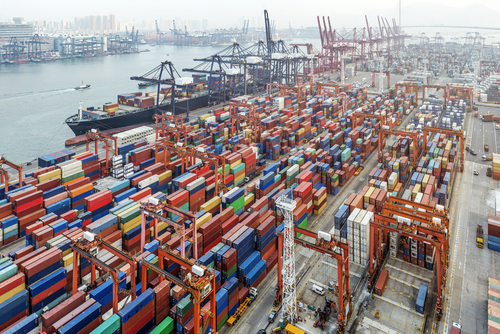The goals of U.S. international economic policy have remained constant: to enhance the prosperity of American citizens while projecting U.S. power and principles globally to enhance the prospects of liberty. Both political parties have embraced
broader trade and an open international economic system to boost domestic prosperity and solidify strategic relationships. And they have viewed America’s role on the world stage as exceptional and believe that the benefits of U.S. leadership accrue both within and beyond U.S. borders.
To this end, there has been a bipartisan, postwar tradition of pursuing globalization and trade liberalization. This has served as a major source of U.S. income and productivity growth, with the former driven by the opportunity to serve markets that encompass 95 percent of the world’s consumers, while the latter is generated by the need to rise in the face of international competition. The enhanced U.S. presence has been a strong contributor to U.S. foreign policy as well.

President Trump withdrew the United States from the Trans-Pacific Partnership (TPP) trade agreement in the early days of his presidency.
Typically, global economic policy objectives for the new Trump administration would focus on expanding the scope of globalization, while deepening the existing links. The wish list would include broader trade agreements, harmonization of regulatory structures, new agreements governing investment and other financial flows, and restrictions on currency manipulation and beggar-thy-neighbor tariff interventions.
Unfortunately, this consensus has evaporated. The new president will face the great challenge of formulating and executing a global economic strategy in the face of a rising tide of domestic isolationism and protectionism. Indeed, as Trump has already withdrawn from the Trans-Pacific Partnership (TPP) and pledged to “renegotiate the North American Free Trade Agreement,” he must find a way to pair these positions with the imperatives of prosperous governance. Meanwhile, across the globe other countries face comparable backlash against migration and international economic policies.
Fortunately, such opportunities will arise, as the key lesson is that there are really no boundaries of global economic policy. Domestic economic policy is in many cases also global economic policy—think, for example, of a monetary easing that simultaneously serves to weaken a country’s currency—and in other cases is a necessary foundation for global economic objectives. Similarly, global economic policy (or “soft power”) is an essential part of national security and international relations.
Accordingly, a large portion of any global economic agenda may be conducted under the more appealing aegis of domestic economic needs or foreign policy objectives. The incoming Trump administration will have specific opportunities in:
Tax reform—specifically, tax reform that features border adjustability, which can assuage populist fears and provide valuable integrity to the tax code, and
Regulatory reform—a more streamlined regulatory state can augment trend growth, raise wages, and dampen populist discontent.

The health of the U.S. economy can often be seen in the rise and fall of new businesses. Since 2007, the rate at which businesses are started has been below the rate at which businesses fail.
A starting point for a global economic agenda is to build the necessary domestic policy foundations. This begins with the generic need to bolster the projected anemic trend rate of economic growth, a targeted need to raise the rate of new firm creation and entrepreneurism, and it includes specific threats that must be addressed in the form of large and explosive federal deficits and an uncompetitive tax code.
At present, the Congressional Budget Office (CBO) estimates that the potential for long- term trend economic growth is 2.0 percent. At this pace, gross domestic product (GDP) per capita—a rough measure of the standard of living—will double every 75 years, a striking falloff from the post–World War II pace of every 35 years. This diminished prospect for prosperity is at the root of the rejection of globalization.
An important symptom of America’s economic ills is the comparison of the rate of new business start-ups and business failures. For the entirety of statistical history, entrepreneurs started businesses at a rate significantly higher than the pace at which businesses failed. Since 2007, however, the start-up rate has fallen significantly and for the past three years has been below the failure rate.
Why is this such a big deal? First, it explains the slow growth of jobs in the recovery because the vast majority of jobs are created by new firms. Second, since new businesses are the way that innovative ideas are introduced to the economy, it underlies the poor productivity growth experienced since 2007 as well. Third, while large global firms dominate the trade statistics, the reality is that the vast majority of U.S. exporters are smaller firms. Their decline, in turn, is the economic foundation of the poor growth in real wages, families’ incomes, and top- line growth during the recovery. So if you want an explanation for bad jobs growth, productivity growth, real wage growth, GDP growth, and perceived failure in trade, then simply focus on the diminished state of the American entrepreneur.
The good news is that the domestic foundations are fixable. The starting point is to put the federal budget in order. Debt in the hands of the public is over $14 trillion and growing rapidly. The latest CBO budget projections show that by 2024—the end of Trump’s second term, should he win one—debt will rise by 50 percent, to $21 trillion. At the same time, the deficit will widen to over $1 trillion, of which over $700 billion will simply be the interest cost on the exploding debt.
Addressing the rapid growth of health, retirement, and other entitlement programs; the nation’s broken tax code; and the rising regulatory burden will improve the nation’s fiscal outlook, growth potential, and international competitiveness.

Exports from the United States bear the cost of U.S. corporate income tax along with the value-added tax of the foreign country.
The primary cause of growing debts is mandatory spending and interest payments. Mandatory spending has been growing as the nation ages, health costs grow, and policy makers create new entitlements and expand old ones. In 1974, mandatory spending was 41 percent of the budget. By 2025, it will be 64 percent. Meanwhile, interest payment on the debt will continue to crowd out the budget as the debt portfolio remains outsized and interest rates normalize.
These pressures reflect legacy costs—past promises—crowding out investment in the future in the form of infrastructure, basic research, and education. The large deficits will require comparable inflows of international capital that are the mirror image of trade and current account deficits. These budget pressures will undercut private investment and feed the populist perception that trade agreements are one reason that the U.S. is “losing” at trade.
Tax reform is a necessary domestic reform that has direct and tangible potential to improve the international policy climate. Today, all the major U.S. trading partners employ a value-added tax (VAT) that includes “border adjustability” as a key feature. Specifically, the VAT is imposed on products that are imported, while being rebated when a product is exported to a foreign country. When countries with VATs trade, competition is on a level tax playing field in each domestic market.
U.S. exports, however, bear the cost of the U.S. corporate income tax (which is not rebatable) and the VAT of the foreign country. In contrast, competitors in that country bear only the VAT cost. Similarly, foreign imports into the U.S. benefit from the VAT rebate in their home country and do not face a comparable imposition of a VAT in the U.S.

The world headquarters for General Motors is in Detroit, Michigan. Many U.S. companies choose to have their headquarters outside of the United States because of corporate taxes.
World Trade Organization (WTO) rules permit border adjustments for consumption- based taxes, which are referred to as indirect taxes. Unfortunately, the same rules preclude border adjustment for direct taxes such as income taxes. Tax reform that includes a rebatable consumed- income, cash flow tax (such as has recently been proposed by a U.S. House of Representatives task force) would permit U.S. firms to compete on a level playing field by applying border adjustments within the context of overall tax reform.
Tax reform of this type would not only substantively improve the quality of the competitive landscape but would also improve the optics of international trade, as the imposition of a border tax on imports could effectively reduce the pressure for tariffs and other interferences with global trade. Bluntly, a border adjustable tax may assuage some populist concerns with international trade.
Border adjustability can be implemented by including in the firm’s tax base only transactions in the domestic market—imports are excluded from deductions (and thus taxed) and exports are excluded from revenues (and thus untaxed). This means that no international transaction that shifts profits reduces a firm’s tax liability. The integrity of the tax base is an important aspect of international tax policy.
The third interaction between tax reform and the global economic agenda is dealing with the headquarters decisions of firms. The U.S. corporate tax code has remained largely unchanged for decades, with the result that the United States has gone from being roughly on par with major trading partners to its current position of imposing the highest statutory rate on corporate income. (While less stark than the high statutory rate, the United States also imposes large effective rates.)
In addition, the United States fails another competitiveness test in the design of its international tax system. The U.S. corporate income tax applies to the worldwide earnings of U.S.- headquartered firms. U.S. companies pay U.S. income taxes on income earned both domestically and abroad, although the U.S. allows a foreign tax credit up to the U.S. tax liability for taxes paid to foreign governments. Active income earned in foreign countries is generally only subject to U.S. income tax once it is repatriated, giving an incentive for companies to reinvest earnings anywhere but the U.S., owing to its high corporate tax rate. This system distorts the international behavior of U.S. firms and essentially traps foreign earnings that might otherwise be repatriated to the U.S.
While the U.S. has maintained an international tax system that disadvantages U.S. firms competing abroad, many U.S. trading partners have shifted toward a territorial system; that system exempts entirely, or to a large degree, foreign-source income. Of the 34 economies in the Organisation for Economic Co-operation and Development (OECD), for example, 28 have adopted such systems, including recent adoption by Japan, the United Kingdom, and New Zealand. According to a 2015 study by the Tax Foundation, the U.S. ranks last in corporate income tax competitiveness compared to OECD countries.

The Obama administration finalized nearly 2,500 regulations.
One manifestation of these flaws is the decadeslong phenomenon of “inversions.” A tax inversion occurs when a U.S.-headquartered firm acquires or merges with a smaller global firm, and relocates for tax purposes in the acquired firm’s country. All inversions begin as a valuable strategic purchase. However, in light of the tax disadvantages, the headquarters must be located abroad.
For example, when a U.S. firm competes with a German firm in Brazil, the German firm pays the Brazilian tax and is done. The U.S. firm pays the Brazilian tax and then a second U.S. layer of tax up to the U.S. rate of 35 percent. (Put differently, it pays 35 percent with a credit for the Brazilian tax.) Thus, from the outset, the high U.S. rate on worldwide dollars puts the U.S. firm at a disadvantage. In an effort to alleviate this tax-based disadvantage, the U.S. defers collecting the second layer of tax until the funds are brought back to the United States. That is, the firm can engineer a level tax playing field if it cedes access to its offshore earnings!
The ramifications are obvious. First, the repatriation tax leads to trillions of U.S. dollars locked offshore and unavailable for hiring, R&D, expansion, or innovation in the U.S. Second, the U.S. is at a disadvantage in decisions over the location of headquarters. Given the opportunity to improve a corporation’s core business, compete on a level global playing field, have access to all its earnings, and meet obligations to shareholders, inversions are born.
Given the large projected federal deficits, the U.S. is likely to require substantial capital inflows over the coming eight years. It would be far better if those inflows took the form of foreign direct investment that raises U.S. productivity. Tax reform that improves the location of cross- border decisions can help in this regard.
The rapid increase in burdensome regulations comes at considerable cost to American businesses, consumers, workers, and the economy as a whole. The Obama Administration finalized nearly 2,500 regulations with a cumulative $600 billion in additional compliance costs and an estimated 400 million net paperwork burden hours. This regulatory onslaught has purely domestic consequences—such as deterring the start-up of new businesses—but also undercuts U.S. efforts to harmonize international financial, commercial, environmental, and labor regulations at lower (and more flexible) U.S. norms. Domestic regulatory reform will strengthen the hand of the U.S. in global regulatory harmonization.
How, then, to proceed on the global front given the open skepticism, and even opposition, of domestic voters? The starting point is the Trans-Pacific Partnership. TPP has become the poster child of the antiglobalization movement, despite the transparent facts that it would have economic benefits (albeit modest) and tremendous strategic advantages.
The new president has chosen to reject the TPP, but has emphasized a preference for “fair” (a term not well specified) bilateral trade agreements. At one extreme, this may permit Trump to follow in the footsteps of Obama and shift from an antitrade campaign to signing multiple bilateral trade agreements and ultimately to negotiating an acceptable TPP. In doing so, it is straightforward to identify those export workers who will benefit most from its passage. However, equally important—and in contrast to past efforts—it will be necessary to genuinely engage in labor market assistance for those workers placed at risk by the TPP and other multilateral agreements. Policy makers underestimated the global labor impacts of the accession of China to the World Trade Organization; the same mistake cannot be repeated. The good news is that these workers form the core of Trump’s political support; they are unlikely to be lost in the shuffle again.
Given the current unpopularity of globalization and large institutions, it is unwise to pursue extensive efforts via the large international institutions, such as the United Nations, International Monetary Fund, World Bank, and Organization for Economic Cooperation and Development. There is an ongoing case for information sharing, but there is little benefit to activist policy making through these bodies.
The political support for traditional global economic policy has evaporated. Fortunately, a great deal of valuable policy can be done via traditional domestic policy instruments such as the federal budget, tax reform, and regulatory efforts. Nevertheless, there will be the need for genuine presidential leadership to restart existing multilateral trade agreements.